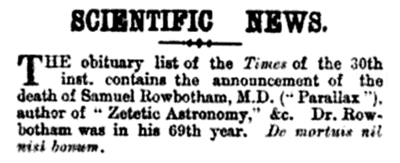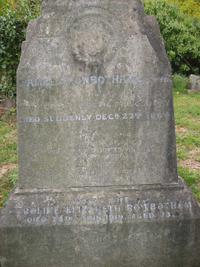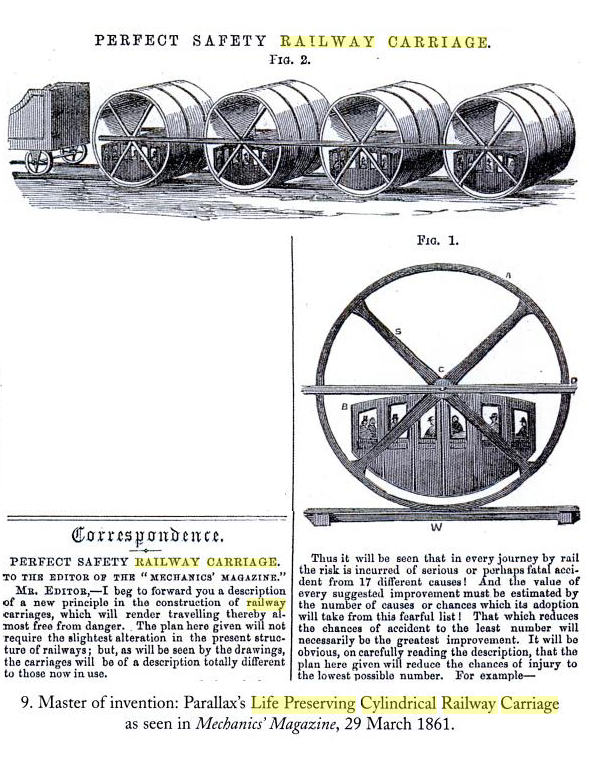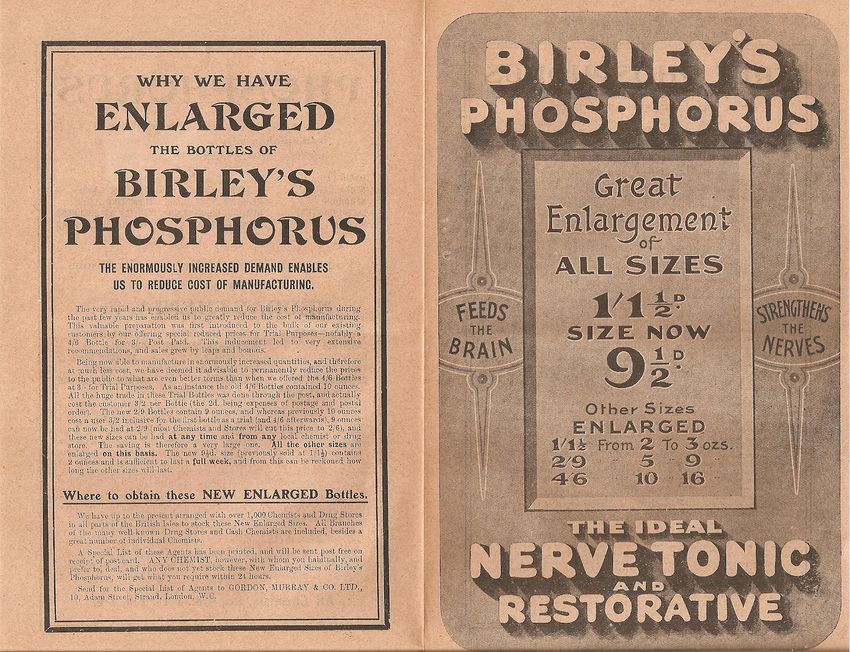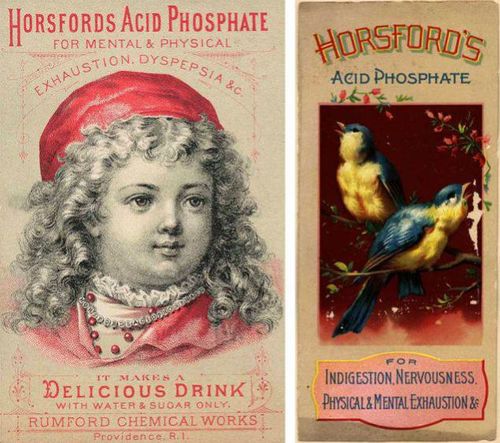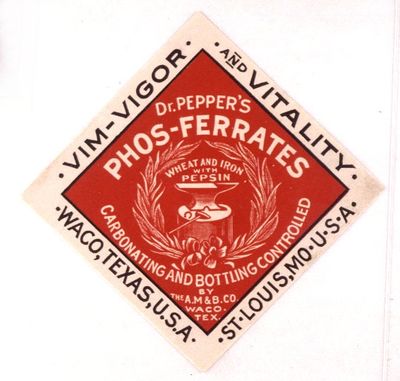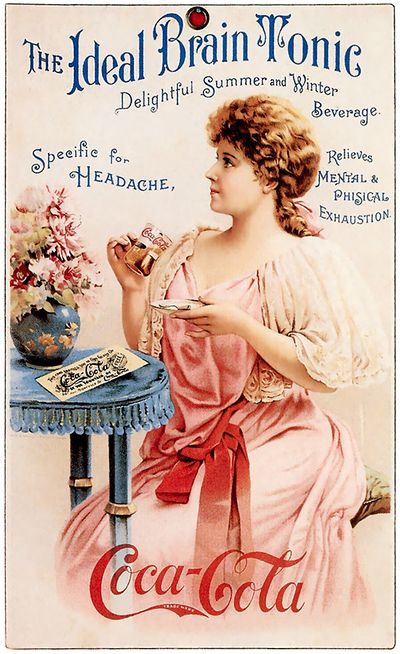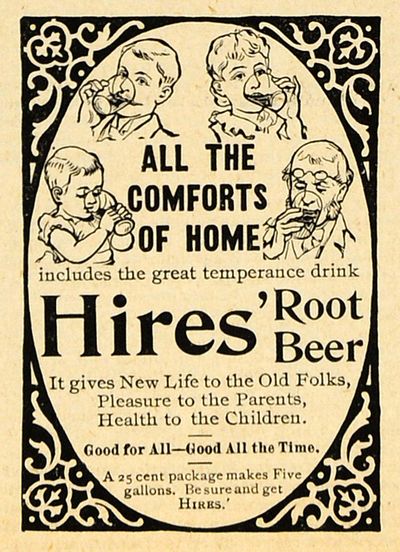Difference between revisions of "Samuel Rowbotham"
Tom Bishop (talk | contribs) |
Tom Bishop (talk | contribs) |
||
| Line 311: | Line 311: | ||
:{{cite|Bread (from wheaten flour), when considered in reference to the amount of nutritious matter it contains, may with justice be called the staff of life; but in regard to the amount of earthly matter, we may with equal justice pronounce it the "staff of death".}} | :{{cite|Bread (from wheaten flour), when considered in reference to the amount of nutritious matter it contains, may with justice be called the staff of life; but in regard to the amount of earthly matter, we may with equal justice pronounce it the "staff of death".}} | ||
| − | On page 4 of an archived issue of | + | On page 4 of an archived issue of the June 11, 1901, edition of ''The Pacific Commercial Advertiser'', we see that seven years after his 1884 death, Rowbotham was known as the author of the phrase: |
https://evols.library.manoa.hawaii.edu/server/api/core/bitstreams/3ba5b4fb-6388-4ca7-bed3-fe1be837453c/content ([https://web.archive.org/web/20221204201135/https://evols.library.manoa.hawaii.edu/server/api/core/bitstreams/3ba5b4fb-6388-4ca7-bed3-fe1be837453c/content Archive]) | https://evols.library.manoa.hawaii.edu/server/api/core/bitstreams/3ba5b4fb-6388-4ca7-bed3-fe1be837453c/content ([https://web.archive.org/web/20221204201135/https://evols.library.manoa.hawaii.edu/server/api/core/bitstreams/3ba5b4fb-6388-4ca7-bed3-fe1be837453c/content Archive]) | ||
Revision as of 00:08, 7 December 2022
Samuel Birley Rowbotham (AKA Parallax) (1816 – 1884), was an English medical doctor and inventor who wrote Zetetic Astronomy: Earth Not a Globe, based on his decades-long scientific studies of the earth, published a 16-page pamphlet (1849), which he later expanded into a 430 page book (1881) expounding his views. According to Rowbotham's scientific method, which he called Zetetic Astronomy, the earth is a flat disk centered at the North Pole and bounded along its southern edge by a wall of ice, with the sun, moon, planets, and stars only a few thousand miles above the surface of the earth.
Rowbotham and his followers gained notoriety by engaging in raucous public debates with leading scientists of the day. One such clash, involving the prominent naturalist Alfred Russel Wallace, led to several lawsuits for fraud and libel.
After Rowbotham's death, his thousands of followers established the Universal Zetetic Society, published a magazine entitled The Earth Not a Globe Review and remained active well into the early part of the 20th century.
Flat Earth Lectures
Over the period of several decades Samuel Birley Rowbotham toured the islands of Britian, giving lectures at prominent universities and institutions of the day. At the conclusion of his lectures he would debate with the brightest minds present over the shape of the earth. Dr. Rowbotham was successful in swaying many members of the audience over to his position. From his efforts a widespread Zetetic movement began, spawning several Zetetic societies, which demanded that the government look into the sphere issue.
The following quotes were published by the press on Rowbotham's lectures:
“ ZETETIC ASTRONOMY.--No doubt many of our readers have been mystified and surprised within the last week by the announcement that, in three lectures, at the Northampton Mechanics' Institute, a gentleman who calls himself 'Parallax,' would undertake to prove the earth not a globe, &c., &c. . . . We were highly gratified by the manner in which this important subject was handled by 'Parallax'--a pseudonym which the lecturer informed his audience he had adopted in order to avert the effect of an insinuation that his startling announcement is but the morbid desire of an individual to be known as the propounder of a philosophy boldly at variance with that of the great astronomers of the past and present. His subject was handled in a plain and easy manner, his language and allusions proving him a man of education and thought, and certainly not a pedant. The experiments mentioned, divested of technicality in their recital, and understandable by all, were of such a nature as to cause a start of surprise at their simplicity and truthfulness. . . . It is not for us to pronounce a verdict upon so important an issue; 'Parallax' may be in error, but as far as his reasonings from fact and experiment go, there is much to set scientific men thinking. His arguments consist of facts, and such as are patent to all degrees of mental capacity. . . . In the discussions which followed, 'Parallax' certainly lost no ground, either in answer to questions or to some broad assertions quoted from learned authorities. ”
—South Mid-land Free Press, August 14th, 1858.
“ 'PARALLAX' AT THE LECTURE HALL.--This talented lecturer is again in Greenwich, rivetting the attention of his audiences, and compelling them to submit to the facts which he brings before them--we say submit, for this they do; it seems impossible for any one to battle with him, so powerful are the weapons he uses. Mathematicians argue with him at the conclusion of his lectures, but it would seem as though they held their weapons by the blade and fought with the handle, for sure enough they put the handle straight into the lecturer's hand, to their own utter discomfiture and chagrin. It remains yet to be seen whether any of our Royal Astronomers will have courage enough to meet him in discussion, or whether they will quietly allow him to give the death-blow to the Newtonian theory, and make converts of our townspeople to his own Zetetic philosophy. If 'Parallax' be wrong, for Heaven's sake let some of our Greenwich stars twinkle at the Hall, and dazzle, confound, or eclipse altogether this wandering one, who is turning men, all over England, out of the Newtonian path. 'Parallax' is making his hearers disgusted with the Newtonian and every other theory, and turning them to a consideration of facts and first principles, from which they know not how to escape. Again we beg and trust that some of our Royal Observatory gentlemen will try to save us, and prevent anything like a Zetetic epidemic prevailing amongst us. ”
—Greenwich Free Press, May 19th, 1862.
“ EARTH NOT A GLOBE.--On Monday last a gentleman adopting the nom de plume of 'Parallax'--a very appropriate name, seeing that the basis of his arguments is the relation to each other of parallel lines--commenced a series of lectures at the Public Hall on 'Zetetic Astronomy,' a system directly opposed to the great Newtonian theory. That he is a clever man, and has studied the matter deeply, and that he is master of his subject, and thoroughly convinced of its truth, is apparent; and his arguments are certainly very plausible. The lecture drew large audiences, and among those present we noticed (here a list is given of many of the leading men and families of the district). 'Parallax' commenced by explaining the word 'Zetetic,' which had been adopted, because they did not sit in their closets and endeavour to frame a theory to explain certain phenomena, but went abroad into the world, and thoroughly investigated the subject. Lengthy and animated discussions ensued; votes of thanks were passed to the lecturer and the chairman-- Nixon Porter, who declared that he was much struck with the simplicity and candour with which the lecturer had stated his views; and, after a promise by 'Parallax' that he would pay another visit to Warrington, the audience dispersed. ”
—Warrington Advertiser, March 24th, 1866.
See: Parallax and His Teachings: Opinions of the Press
Obituary
The American Association for the Advancement of Science lists him as Dr. Samuel Rowbotham in his 1885 obituary, as does the obituary in Engligh Mechanic and World of Science. The Bookseller obituary confirms he was a practicing doctor of medicine as a "legitimate profession with immense success" (Archive).
“ For some years past Dr. Rowbotham, in the name of Dr. Birley, exercised his legitimate profession with immense success. He had a special medicine of his own manufacture, "Free Phosphorous," which was reputed to be efficacious in the cure of a variety of ailments. For some years past Dr. Rowbotham could never under any consideration be induced to travel by rail. Patients or friends at a distance wishing to see him had to send their carriages for him, and within the last few months he visited Brighton for the benefit of his health, journeying to and fro in a private carriage. Curiously enough the mode of conveyance in which he placed his faith, accelerated his death. On an occasion, several months past, when alighting from a cab he slipped and injured his leg, and from that time his health gradually failed. ”
From English Mechanic and the World of Science (Jan 2, 1885) (Archive):
Tombstone
Forum member Thork was able to find Dr. Rowbotham's tombstone at findagrave.com:
“ His tombstone reads "Samuel Rowbotham, M.D., Ph.D., Founder of Zetetic Philosophy, died suddenly Dec. 23rd. 1884." (An eight-line poem follows : most of it has faded, but the last line is "Upon the scroll of fame.") And his wife, Caroline Elizabeth Rowbotham, died 28th. June 1919, aged 73.' (There is another poem under her name, but not one word of it is readable.) ”
Inventions
Fire Resistant Starch
A patent acceptance shows that Dr. Samuel Birley Rowbotham was granted a patent for inflammable starch for use in fabrics and other substances (Archive):
“ Specification of the Patent granted to Samuel Rowbotham, of Putney, in the County of Surry, Doctor of Medicine, and Thomas Gratton, of Derby, in the County of Derby, for A Composition for Rendering Uninflammable Linen, Cotton, Silk, or other Inflammable Fabrics and Substances.—Dated January 2, 1860 ”
Caustic Soda
Rowbotham was granted a patent for making Caustic Soda (Archive):
“ I, Samuel Rowbotham, of Brookside, Penketh, near Warrington, in the County Palatine of Lancaster, do hereby declare the nature of the said invention for “Making caustic soda from common salt or chloride of sodium by the action of lead or its oxide, and afterwards recovering the lead as oxide or otherwise for use again in making caustic soda from common table salt." to be as follows:- ”
Composite Soap
Samuel Rowbotham is co-inventor of a composite soap (Archive):
“ We make into a paste a solution of caustic potash or ammonia or other alkali with pipe-clay or such like similar substance, and then mix the paste with any kind of soap according to the purpose for which it is intended, and formed into bars or cakes as required. Thus the cleansing properties are much increased by absorbing all grease and other extraneous matter. ”
Life Preserving Railway Carriage
Rowbotham is also inventor of the Life Preserving Cylindrical Railway Carriage.
Medical Career
Like other doctors and medical researchers at the time[1], Rowbotham studied and promoted phosphorous due to its apparent medical benefits.
Asthma
Rowbotham's work is cited in several medical texts:
From Consumption and Tuberculosis (Archive) by John Francis Churchill, M.D., we see:
The above suggests that other medical professionals considered Rowbotham's work to be a 'medicinal fact upon record'.
In Materia Medica and Therapeutics (Archive) by Thomas D. Mitchell, M.D., we find:
Indeed, Rowbotham's asthma treatment has survived the test of time and is still in use. A 2006 copyrighted work by Thomas John Graham promotes and shares Rowbotham's asthma treatment for his readers. On p.103 of Ayurvedic materia medica for domestic use (Archive) we see:
See Also
Phosphorous Studies
It is thought that Rowbotham was one of the leading proponents of the phosphorous revolution in the 1800's. Beginning in the early 1840's, Rowbotham published numerous articles and works on the subject.
References and advertisements:
- "In the year 1842, Dr. Birley drew public attention to the value of Phosphorus as an article of Diet and Medicine" (Archive)
- Rowbotham describes the discovery, benefits and workings of Phosphorous here in The Harmsworth (Archive)
- Brain Power: Its Attainment and Preservation (Archive)
- Book: Phosphorus, as discovered and prepared by Dr. Birley
- Reference to the "Birley Treatment" (Archive)
- T.P.'s Weekly "The Wonders of Phosphorous" (Archive)
- Studying a Subject Fifty Years (Archive)
- Dr. Birley's Phosphorous in Womanhood Vol. 14 (Archive)
- Extracts from the essays of S.Rowbotham (Archive)
- Dr. Birley's Compounds of Free (or Unoxidised) Phosphorus : Fifteen Standard Combinations. A Special Remedy For Each Disease.
Rowbotham mixed phosphorous with other medicaments (Archive) to enhance their helpful qualities:
“ Birley's Preperations—More than forty years ago Dr. Samuel Birley advocated the use of free phosphorus in the treatment of disease. He did not consider it the “cure all,” but by judicious combination of other medicaments with phosphorus as the basis, he pretty nearly exhausted the more active members of the materia medica. Messrs. Gordon, Murray & Co., of 17 Castle Street, Holborn, E.C., are carrying out this theory, and have placed on the market no fewer than twenty different kinds of syrups of phosphorus—plain, ironised, magnesian, hepatitic, and so on—and are bringing them before the public in a forcible manner. All have their special uses, and have been for many years used in private practice. The plain syrup is an elegant preparation of free phosphorus in which the nauseous taste is fully disguised. ”
Phosphorous Medical Drinks
Dr. Samuel Birley Rowbotham was a pioneer of the phosphate medical drink industry of the 1800's, which offered phosphorous and phosphate-based medical drinks that were reputed to be beneficial for a number of health ailments. He marketed a drink called "Birley's Phosphorous":
Phosphorous Revolution
After Rowotham's championing of the medicinal benefits of phosphorus and the sale of his phosphorous medical beverage through the mid 1800's, the phosphate soda industry is launched in the late 1870's:
http://www.answers.com/topic/soft-drink
“ Phosphate soda
A variant of soda in the United States called "phosphate soda" appeared in the late 1870s. It became one of the most popular soda fountain drinks from 1900 through the 1930s, with the lime or orange phosphate being the most basic. The drink consists of 1 US fl oz (30 ml) fruit syrup, 1/2 teaspoon of phosphoric acid, and enough carbonated water and ice to fill a glass. This drink was commonly served in pharmacies. ”
https://delishably.com/beverages/SodaPops-of-the-1800s-1900s-20s-30s-40s-50s-and-60s (Archive)
“ The Early Days of Soda Pop and Soft Drinks
The earliest types of carbonated soft drinks were waters found in natural mineral springs. In the 13th century, fruits, herbs, flowers and vegetation (such as dandelions) were used to ferment and flavor carbonated waters. Non-carbonated soft drinks made up of water, honey, and lemon juice appeared in the late 1600s. In 1767, Englishman Joseph Priestley mixed water and carbon dioxide, the result was soda (carbonated) water. Juices, wines, and spices were added to the soda water; the products were sold in English pharmacies.
Phosphate soda was introduced in the United States in the late 19th century. Soda fountain drinks with fruit juice, phosphoric acid, and carbonated water became very popular and by the early 1920s, most drugstores featured soda fountains. ”
Competitors
Dr. Rowbotham had a number of competitors in the phosphate medical drink industry, including Dr. Pepper and Coca-Cola. These carbonated drinks were commonly thought to be healthy by the medical profession at the time. Coca-Cola was sold as a patent medicine. Both it and Dr. Pepper were started by pharmacists. Indeed, Dr. Rowbotham preceded them in history.
Phosphorous Medical Research
Today, according to modern sources, Phosphorous is agreed to be one of the most important elements in the human body:
http://www.ehow.com/about_5410083_phosphorus.html
- “ Phosphorus in the human body
- Despite the fact that it is a highly poisonous substance, phosphorus is one of the most important elements for human beings. It is said to be the second most abundant substance in the body. It is found in the bones, blood and bodily fluids. It is also found in various body organs such as the heart, the brain and the kidneys, where it plays a very important role in organ function. The main function of phosphorus is the production of bones and teeth. This makes phosphorus an essential nutrient for life to be normal.
- How phosphorus works in the body
- Almost all physiological chemical processes and reactions in the body are regulated by the presence of phosphorus. For phosphorus to function properly in the body, there should be Vitamin D and calcium available. It is essential in the strengthening and protection of cell membranes; it assists the other nutrients, chemicals and hormones to function properly. It is essential for good nerve impulses, normal functioning of the kidneys and the way fats, proteins and carbohydrates are synthesized for growth. It is also a part of DNA and RNA. ”
- Phosphorous has a rich history. Throughout the 1800's higher doses of phosphorous was closely studied by the medical community for its medicinal benefits. Phosphorous was said to be beneficial and curative for a number of ailments.
Neuralgia
From a medical text: Phosphorous in the Treatment of Nerualgia (1875) (Archive) in Transactions of the American Neurological Association, Volume 1, we find that Phosphorous was highly beneficial for treating Neuralgia:
- “ Compared with the whole range of diseases in which phosphorus is said to have been tested, the list of affections in which it has been proven to be beneficial that I have to offer covers a narrow field.
- In the relief of the cruel pains to which the cranial nerves are so commonly subject, and in the cure of the neuralgic condition itself, I have found phosphorus deserving of all the praise that has been bestowed upon it. Its curative effect upon the pure neuralgias, especially of the trigeminus, almost establishes its right to the title of a specific against this particular affection. (A glance at the condensed table of results will show, without the necessity of repetition, the number of cases of trifacial or trigeminal neuralgia, etc., treated, whether complicated or uncomplicated, and the result.) In the large number of these trigeminal cases, the cure or relief followed the administration of the drug very speedily, often in twenty-four to forty-eight hours, and the same remark applies to the cases of cervico-occipital neuralgia. ”
A list of cases appears here (Archive)
Cholera
Phosphorous has also been used to treat Cholera, producing success in even "advanced stages of Cholara, usually regarded as hopeless". From Materia Medica and Therapeutics (1857) on p.649 we see (Archive):
- “ Phosphorus has been employed successfully by an English physician, in the advanced stage of cholera, usually regarded as hopeless. In 1833 he published his experience with this medicine in the London Lancet, and in the same journal for February, 1850, he reiterates the same views. His reliance has been chiefly on the following prescription:
-
- R.—Phosphor. ӡSS;
- Cer. alb. ӡSS.
- With the aid of enough water to avoid combustion, rub these articles well together, divide the mass into ten pills, which should be kept in a small bottle containing pure water.
- In far-advanced cases, these pills were the only reliable medicine. One was given every ten minutes, followed by a little water. Three pills usually sufficed to arrest the cramps, the vomiting and purging. In milder cases, the first medicine given was as follows:—
-
- R.—Nit. acid fort., from three to five drops;
- Tinct. opii, four to eight drops;
- Syrup croci, a drachm;
- Aquæ, an ounce and a half.
- Mix for a draught, which very frequently answered the end in view. If this failed, the pills were administered as above stated.
- Some six or eight cases are detailed to show the value of this practice. (See London Lancet, February, 1850.) ”
Fevers, Delerium, Tremors
In Materia Medica and Therapeutics (Archive) Dr. Mitchell relays the following accounts:
- “ A considerable number of cases reported by Dr. Wolff, in 1793, would seem to show the good effects of phosphoric ether in low fevers attended with delirium, tremors, feeble pulse, petecchiæ, &c. Five drops of a very strong solution were given every three hours. The pulse improved after a few doses had been given, and equable heat pervaded the system, a pleasant moisture covered the skin, and the delirium subsided. Much testimony of a similar nature could be adduced; and there can be no doubt that salutary results have followed in judicious hands. It is true, however, that much mischief was apparent, as the consequence of the indiscriminate employment of the article, in the days of its greatest celebrity. ”
Overdose Risk
Phosphorous research by the medical community was possibly discontinued because of its poisonous effects when abused:
From the Materia Medica and Therapeutics section titled Phospherous A Poison (Archive) we see:
- “ A French chemist determined to test the power of phosphorus in his own person, and took a grain, with a good deal of sugar, for his first dose. On the next day he tried two grains, and on the next, three. Violent vomiting soon came on, with inflammation of the bowels, delirium, spasms, &c., and although vigorous measures were adopted, he perished, a victim of his own folly. ”
Further Reading
- Phosphorus: Its Claims as a Therapeutic Agent (Archive) by Wm. Mason Turner, B. Ph: M.D.
Theory of Disease
Rowbotham held an innovative theory that many diseases were caused by degradation of the nervous system. His theory is explained in Dr. Birley’s Compounds of Free (or Unoxidized) Phosphorous, published in the year 1900 by Gordon, Murry & Co. –
https://archive.org/details/b30470961/page/4/mode/2up
- “ We might go on with illustrations of this kind sufficient to fill a thousand paged volume, but we think the above are sufficient to give an idea of the view taken by Dr. Birley. He strongly held that a very large number of diseases (even Cancer not excepted) are due to a weakening or lowering of the nerve force, which thus enables the various germs—Bacteria, Baccilli, Micrococci, etc. etc.,—as well as troubles, due to other causes than germs, to encroach upon, and take hold of our flesh. Dr. Birley’s great rule therefore as a GUIDE TO HEALTH is to “Look after the nervous system, keep it well nourished, and in perfect working order, and disease will little affect us.” ”
Cancer-Nervous System Association
One position held by his modern supporters is that Rowbotham was ahead of his time in not only Earth Science, but Medical Science as well. Interestingly, there is modern evidence which suggests an association with cancer and the nervous system, in line with Rowbotham's theory that such diseases were caused by nervous system degradation. Products that are known to cause cancer are also known to cause damage to the nervous system. Different types of cancer are also associated with specific types of nervous system disorders.
Smoking is known to cause cancer, for example, but it is also seen to cause neurological damage:
https://www.sciencedaily.com/releases/2009/06/090623090400.htm (Archive)
- “ Researchers, led by Debapriya Ghosh and Dr Anirban Basu from the Indian National Brain Research Center (NBRC), have found that a compound in tobacco provokes white blood cells in the central nervous system to attack healthy cells, leading to severe neurological damage. ”
Radiation is known to cause cancer, and is also known to cause nervous system damage:
https://www.iaea.org/sites/default/files/publications/magazines/bulletin/bull3-4/03405800607.pdf (Archive)
- “ Until recently it had been generally believed that the tissue of the nervous system was especially resistant to radiation and that any kind of damage to it could occur only at extremely high radiation doses. Over the past few years, however, there has been increasing evidence to show that the nervous system responds to even small doses of radiation and that this response may often be associated with some form of radiation damage. ”
There is an association with nervous system disorders and cancer. Vulnerability to stress and the nervous system disorder Schizophrenia are associated with increased risk of Breast Cancer, the most commonly diagnosed cancer among women.
https://www.nature.com/articles/s41467-020-18492-8 (Archive)
- “ Breast cancer is the most commonly diagnosed cancer among women worldwide1. Some evidence suggests that vulnerability to stress2,3,4, particularly indicated by the presence of psychiatric disorders including schizophrenia5,6, may be associated with increased risk of subsequent breast cancer.
- ~
- Schizophrenia was associated with a 49% increased risk of subsequent invasive breast cancer (95% confidence interval (CI), 37-63%, P = 1.72 × 10−19; Table 1).
- ~
- Despite lower screening attendance19, it has recently been recognized that patients with schizophrenia are at increased risk of breast cancer6 but not of cancer overall30,31. ”
The most common type of skin cancer is Melanoma, and it is "surprising" that it is associated with the nervous system disorder Parkinson's Disease.
https://parkinsonsdisease.net/clinical/melanoma-skin-cancer-link (Archive)
- “ A Surprising Relationship: Parkinson’s Disease & Melanoma
- Melanoma is a type of skin cancer that develops from melanocytes, and Parkinson’s disease (PD) is a progressive movement disorder that affects the nervous system.
- ~
- The link between melanoma & Parkinson’s
- The relationship between melanoma and PD runs both ways: Specifically, people with PD are 4x more likely to develop melanoma, and people with melanoma have 4x the risk of developing PD.1 ”
This association may be surprising to the parkinsonsdisease.net medical editors, but Rowbotham would not be surprised. The association with nervous system degradation and cancer was long predicted by Dr. Samuel Birley Rowbotham in the Victorian Era.
Dr. Rowbtham's medical work has been lost to history, and medical researchers are only recently rediscovering his association between the nervous system and cancer. From a 2018 paper in the Journal of Experimental & Clinical Cancer Research:
https://jeccr.biomedcentral.com/articles/10.1186/s13046-018-0674-x (Archive)
- “ However, only in recent years the role of the nervous system has been recognized as a major contributor to cancer development and metastasis. The nervous system governs functional activities of many organs, and, as tumors are not independent organs within an organism, this system is integrally involved in tumor growth and progression. ”
Investigation into Premature Death
During his life Samuel Rowbotham was also interested in the cause of aging and natural death, and devoted time into investigating its causes. He looked into topics such as why some people develop serious diseases early, why some people seem to age faster than others, and why it is claimed that some people have lived unusually long lives. Rowbotham theorizes that premature death is chiefly related to nutrition and points out nutritional differences between diets in Victorian England and some less-modern cultures where claims to have lived older than 100 years was more common. Specifically, it is pointed out that wheat and common table salt are modern additions to human nutrition which may be related to the cause of premature death.
Paleo Diet
Rowbotham's work may have been an original inspiration for, or at least preceded, what is now known as the Paleolithic diet. In this diet it is suggested that healthier outcomes to life are achieved by cutting out modern foods from our diet and return to the way our early hunter-gatherer ancestors ate. This benefits of this diet is reputed to have reduced conditions such as obesity, heart disease, and diabetes.
Credit for this diet is usually given to Emmet Densmore M.D., (bio), but it is seen in his main work on the topic, How Nature Cures (1892), that Densmore describes and quotes Rowbotham's theories at length as a prior work:
- “ We have come into possession of an old and rare pamphlet of less than 100 pages which is pregnant with striking scientific facts and philosophical discussions, and is remarkably pertinent to the main contention that bread, cereals, and pulses are unwholesome foods for man. It consists of "an inquiry into the cause of natural death, or death from old age; and develops an entirely new and certain method of preserving active and healthy life for an extraordinary period." written by one S. Rowbotham, author of an essay on Human Parturition, etc.; and it was published by Abel Heywood, Manchester, in 1845. We are informed that Mr. Rowbotham practiced medicine in Stockport some fifty years since. According to the English custom among surgeons, he did not assume the title of doctor. His writings give inherent proof of his culture and ability. The following is taken from the preface:
- "Let it not be said that the life of man cannot be prolonged to many times the present period of his existence, because it is not so; as it was said that traveling by stream could never be accomplished, because passengers and luggage has been carried so long only by coaches and pack-horses. It does not follow that because a thing is not, or has not been, that it therefore cannot be. Yet this is the common mode of reasoning adopted by the world; this alone has been sufficient to bring down ridicule, and even punishment and death, upon those who have ventured to propose anything out of the common path, even though it has ultimately been the source of great delight to the persecutors themselves. Human improvement, and progression toward a better state of existence, will ever be retarded if discoveries and inventions are to be judges in a such a foolish, unbecoming manner. Let the groundwork of every new subject be examined, and if found to be correct in principle—if truth be at the foundation—what has the world to fear from the consequences? Are we so far wedded to old notions and practices, even though they constitute a very old personification of falsehood and misery, that we are afraid of the truth, and tremble lest is makes us happier?" ”
In the proceeding pages of his book Dr. Densmore continues to quote Rowbotham's work at length on his investigation into death and aging, championing Rowbotham's investigation, theories, and recommendations with a personal awe and fascination.
It is even seen that Dr. Densmore has been attributed to be the author of one of Rowbotham's dietary nutrition catchphrases verbatim. Bread is given the label of the "staff of death", and this can be found to have been attributed to both Densmore and Rowbotham:
Emmet Densmore Attributions
The Easy Recipe Depot describes the Paleo Diet as the child of Dr. Emmet Densmore:
https://easyrecipedepot.com/paleo-diet-food-list/ (Archive)
- “ The Paleo diet is hot right now – and for good reasons. What you might not know is that the idea of eating like a paleolithic-era human got its start back in the 1890s, when Dr. Emmet Densmore called bread the “staff of death” rather than the more-common staff of life. ”
From Chapter 1 of Kill the Killer with Paleo Diet by Susan Zeppieri on the history of the Paleo Diet:
History of the Paleo Diet
- “ Writers Adienne Rose Johnson, John Harvey Kellod, and Emmet Densmore believed that the primitive eating pattern of The Paleo Diet was far superior to any other dietary habits. Their writitngs on the subject can be traced back to the 1890s. While Kellogg was all about a diet of grain-based and starchy foods, which can be traced back to "the ways and likings of our primitive ancestors," (Priceonomics, 2016), Densmore believed that bread was "the staff of death" (Densmore, 1890) ”
Samuel Rowbotham Attributions
In Chapter 2 of More things in Heaven and Earth by Patrick Moore and Bob Forrest, an anti-Flat Earth historical account, we read about Samuel Rowbotham's work (Archive):
- “ Fish, milk, eggs, fruit, berries and leaves were good for the body in that they contained relatively little earthy matter. Dates, however, were very bad for the system, and as for bread made from wheaten flour, well that was positively dangerous. So much so that Rowbotham insisted on calling it “the Staff of Death” rather than “the Staff of Life”! ”
In this work these authors also declare that Rowbotham was a quack, and after the above quote states that "No-one today remembers Rowbotham’s quasi-medical ideas", despite the "Staff of Death" quote given almost immediately prior being a part of the very inspiration and basis of the popular Paleo Diet with its identical nutritional catchphrase. We can only see this as a fault of the authors for failing to perform a basic Google search on this phrase in their research.
On page 253 of How Nature Cures (1892) the Paleo Diet father Dr. Densmore even cites and attributes Rowbotham directly on the "staff of death" quote, which somehow later became attributed to Dr. Densmore. On the fourth page into continuous Rowbotham quotes he cites the following from a 1845 work from Rowbotham:
- “ Bread (from wheaten flour), when considered in reference to the amount of nutritious matter it contains, may with justice be called the staff of life; but in regard to the amount of earthly matter, we may with equal justice pronounce it the "staff of death". ”
On page 4 of an archived issue of the June 11, 1901, edition of The Pacific Commercial Advertiser, we see that seven years after his 1884 death, Rowbotham was known as the author of the phrase:
https://evols.library.manoa.hawaii.edu/server/api/core/bitstreams/3ba5b4fb-6388-4ca7-bed3-fe1be837453c/content (Archive)
- “ In a brief note a correspondent, touching the matter of suitable foods, asks the Advertiser why it calls bread "the staff of death?" We answer that it is not because Rowbotham does, but because that eminent authority has a scientific reason for saying so. The physical phenomena of old age, let us explain, are due to the deposit of earth salts in the arteries, a deposit which clogs them, diminishes their size and atlast prevents the brain from getting its necessary supply of food. Bread, like all cereals, contains earth salts in abundance, and "life is threatened by every loaf we eat." Sooner or later the starch tells on the arterial system. ”
Religion
On the topic of religion, Rowbotham describes that it is a fallacy to push religion based on belief alone, and holds that those who champion the teachings of Scripture should seek to demonstrate its teachings. As an example, the Scriptures describe an Earth which is flat and the central body of the universe. If it is discovered that this cosmology is true, then it is only logical that this evidence stands in favor of Scripture.
In the closing chapter of Earth Not a Globe Rowbotham states:
- “ It is quite as faulty and unjust for the religious devotee to urge the teaching of Scripture against the theories of the philosopher simply because he believes them to be true, as it is for the philosopher to defend his theories against Scripture for no other reason than that he disbelieves them. The whole matter must be taken out of the region of belief and disbelief. In regard to elements and phenomena belief and disbelief should never be named. Men differ in their powers of conception and concatenation; and, therefore, what may readily be believed by some, others may find impossible to believe. Belief is a state of mind which should be exerted only in relation to matters confessedly beyond the direct reach of our senses, and in regard to which it is meritorious to believe. But in reference to matter, and material combinations and phenomena, we should be content with nothing less than conviction, the result of special practical experimental investigation. ”
He continues:
- “ The Christian will be greatly strengthened, and his mind more completely satisfied, by having it in his power to demonstrate that the Scriptures are philosophically true, than he could possibly be by the simple belief in their truthfulness unsupported by practical evidence. On the other hand, the atheist or the disbeliever in the Scriptures, who is met by the Christian on purely scientific grounds, will be led to listen with more respect, and to pay more regard to the reasons advanced than he would concede to the purely religious belief or to any argument founded upon faith alone. ”
Rowbotham says that facts trump belief, and encourages the religious to engage in a collection of evidence to back up belief. Those religious proponents should seek to collect evidence to demonstrate the Scriptures to be true, which provides better argument than faith alone.
- “ If, after the severest criticism, and comparison with known causes of phenomena, the Scriptures are thus found to be absolutely truthful in their literal expressions, it is simply just and wise that we take them as standards by which to test the truth or falsehood of all systems or teachings which may hereafter be presented to the world. Philosophy is no longer to be employed as a test of Scriptural truth, but the Scriptures ought and may with safety and satisfaction be applied as the test of all philosophy. They are not, however, to be used as a test of science and philosophy simply because they are thought or believed to be written or dictated by inspiration, but because their literal teachings in regard to natural phenomena are demonstrably true. ”
In essence, the Flat Earth investigation represents, not only the truth of our world, but may also represent physical evidence for the Bible. In the final chapter of his work Rowbotham answers a frequently asked question of "Who cares?" and "What does it matter if the earth is flat?", a question which has been asked on this subject on countless occasions. If the earth is flat, central, with a moving sun, which exists over a void, with small stars, etc., and the world in which we live happens to be exactly as the ancients depicted it in their religious texts, it would matter quite a lot. It might suggest that someone or something gave them that knowledge.
- “ If after so many ages of mental struggling, of speculation and trial, of change and counterchange, we have at length discovered that all astronomical theories are false; that the earth is a plane, and motionless, and that the various luminaries above it are lights only and not worlds; and that these very facts have been declared and recorded in a work which has been handed down to us from the earliest times--from a time, in fact, when mankind had lived so short a period upon the earth that they could not have had sufficient experience to enable them to criticise and doubt, much less to invent and speculate--it follows that whoever dictated and caused such doctrines to be recorded and preserved to all generations must have been superhuman, omniscient, and to the earth and its inhabitants pre-existent. That Being could only be the Creator of the world, and His truth is recorded in the Sacred Writings. The Scriptures--the Bible, therefore, cannot be other than the word and teaching of God. Let it once be seen that such a conclusion is a logical necessity; that the sum of the purely practical evidence which has been collected compels us to acknowledge this, and we find ourselves in possession of a solid and certain foundation for all our future investigations. ”

